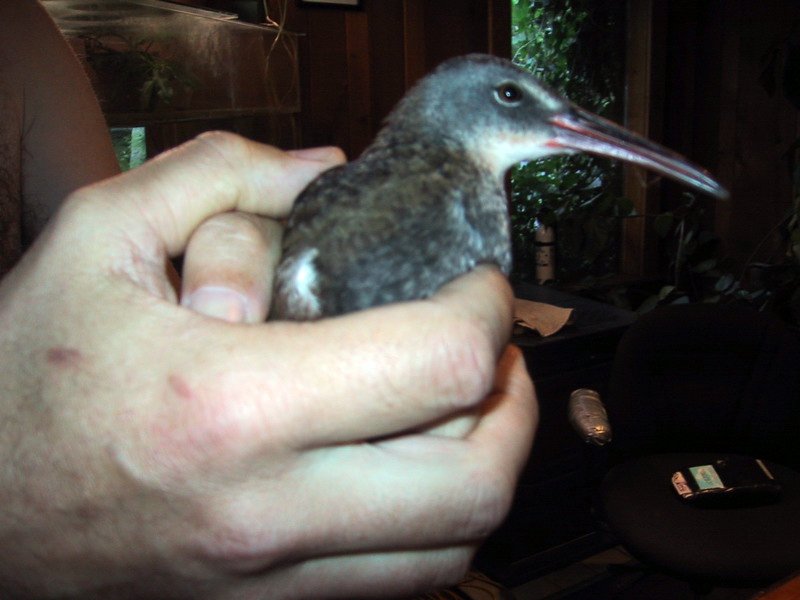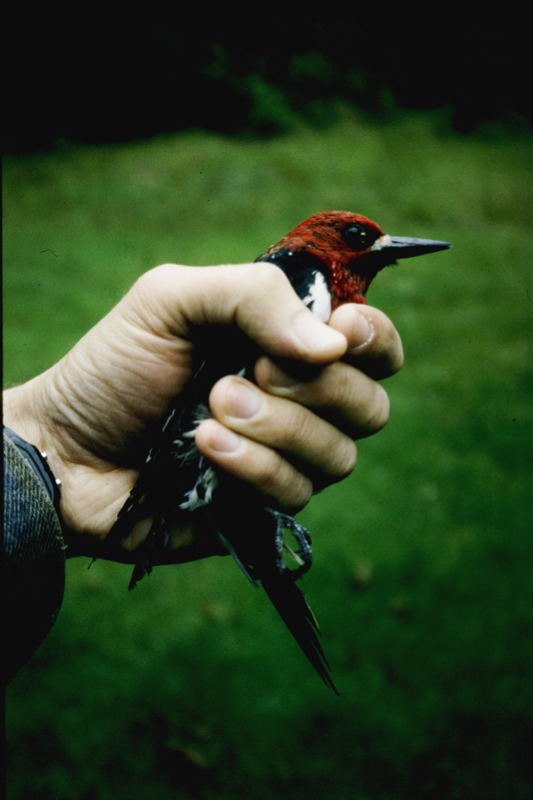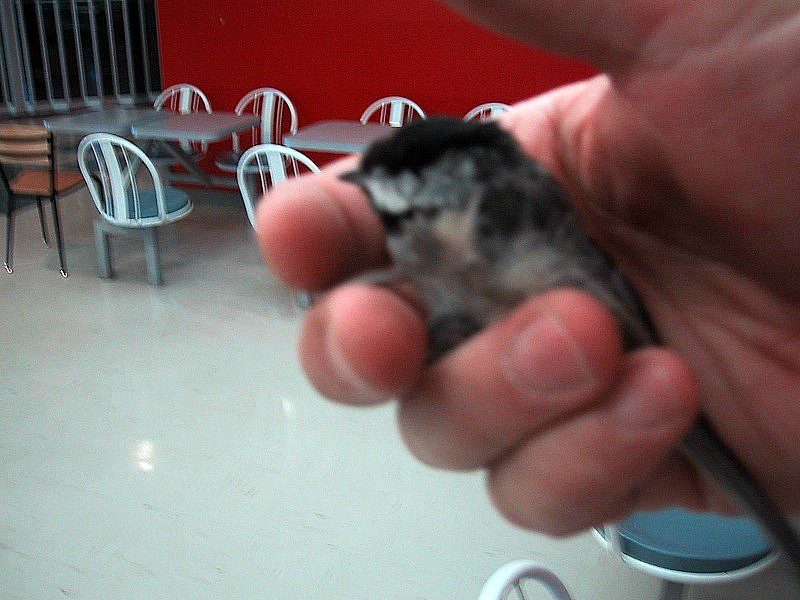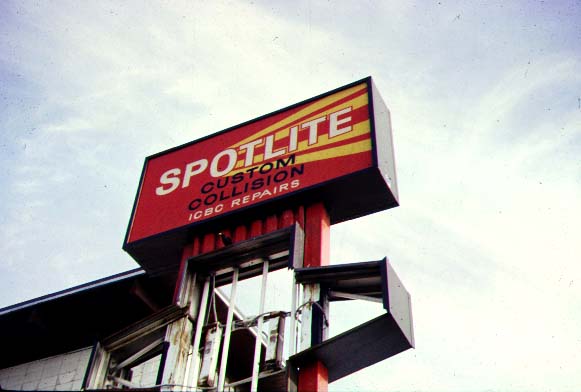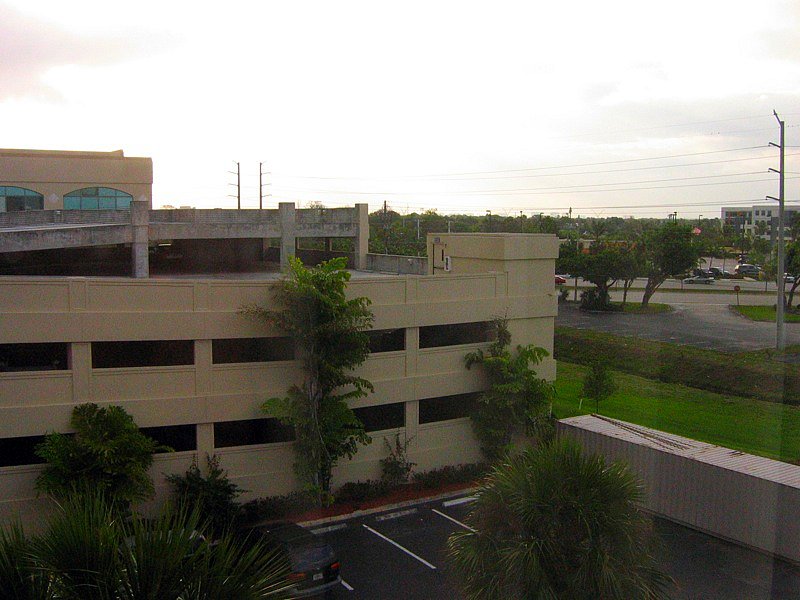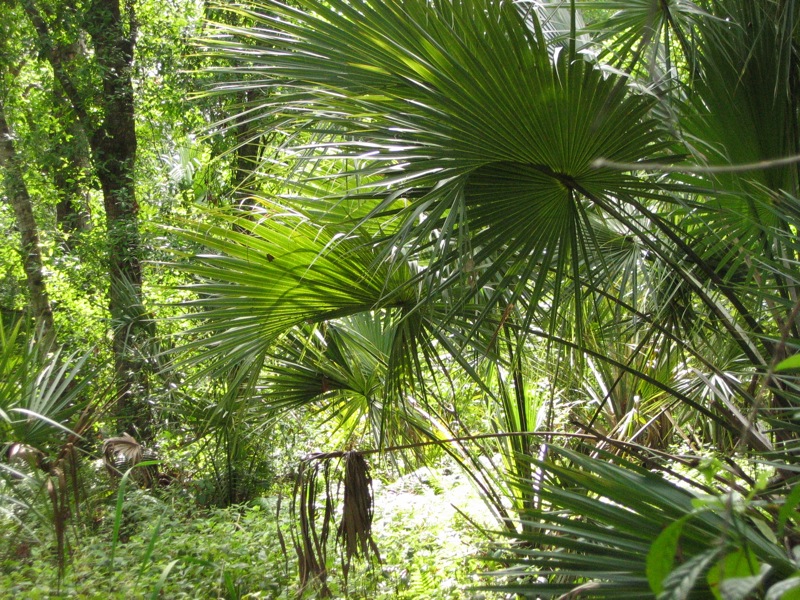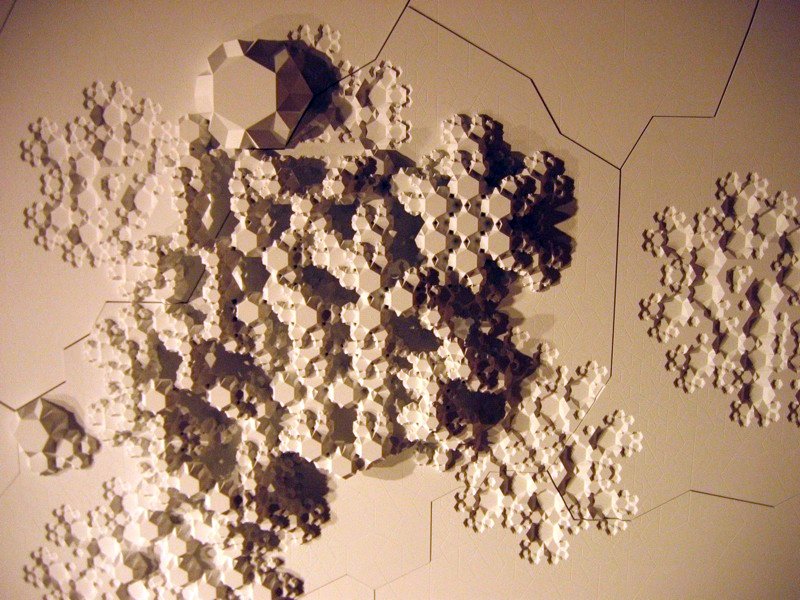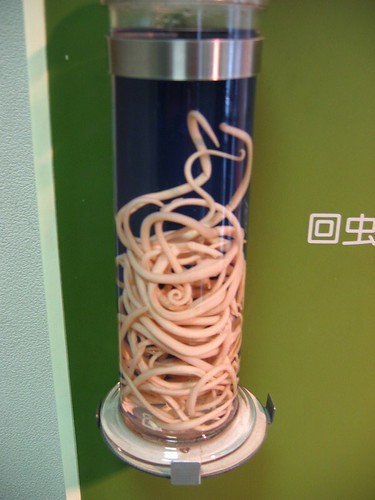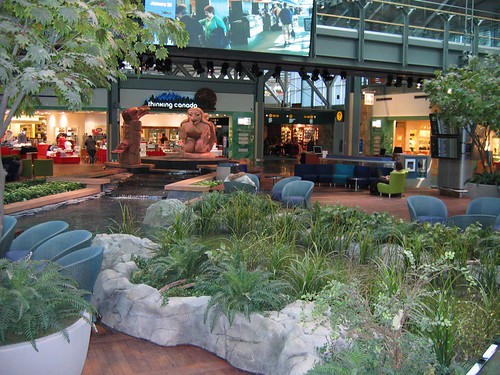We are never really alone. I’ve been out in the rain forest observing slime molds and am completely beguiled by them. These are the pictures I took yesterday. Ancient as time, the slime mold is a colony of tiny amoeba-like things that coagulate occasionally into a super-organism, which oozes toward new feeding grounds, or an auspicious place to sporulate. With its mission accomplished, the mass dissipates back into individual organisms and disappears into the soil. They have no brain or nervous system of any kind, yet slime molds are able to make complex decisions when they aggregate into these entities, including being able to solve mazes. This is accomplished via a secret chemical language that allows information to flow between adjoining individuals. When added together, this simple network creates a superior collective intelligence without the need for any kind of centralized command structure. When the urge to eat or reproduce besets enough individuals, they reach critical mass and just slime their way toward their objective. A simple but effective strategy. But if we adopted it, what would we do with all those bosses? Billions of years before the internet, and the slime molds had already perfected the cohering mechanism of ad hocracies like Digg or open source software development. The way I figure it, the status of the lowly slime mold needs to be elevated. They are such an inspiration. –Lord Running Clam, I salute you!
|
||||||
|
I don’t look for them particularly. I’m not what you’d call a bird ‘watcher.’ I’m more of a bird finder. I seem to come across them everywhere; injured, panicked or hopelessly lost. I’ve pried them from the jaws of cats, carried them quivering out of the buzzing labyrinths of shopping mall food courts and plucked them from windowsills where they have been battering themselves against their own reflections. Trembling, nictitating and bedraggled, the world’s birds are in trouble. Populations of many previously common species are now in free fall, both in Canada and around the world. We stand on the threshold of a bleak new age of summers where barn swallows no longer course through the warm evening air and the haunts of meadowlarks lie extinguished beneath strip mall parking lots. What is it about Florida? As a kid, waiting out the long Toronto winter in my parents’ rec room, I often wondered what it might be like. I’d seen a picture in a book somewhere, of a down-at-the-heels, roadside serpentarium, where burly men in pompadours would wrestle alligators in a dusty yard. It was somewhere in Florida, the book said. I wanted desperately to go there. But it was not to be. Not until well into my adulthood anyway. And I never did find that serpentarium. So I had to settle for a kind of Florida of the mind. The television programs of the time were saturated with images of a fantastically exotic, subtropical America, where smiling swamp rangers skimmed across the Everglades on air boats, at the beck-and-call of puffy-faced little boys, who had winsome animal mascots like Flipper, the dolphin who just wouldn’t shut up and Gentle Ben, a toothless, overweight bear. During the commercials, the über-creepy Anita Bryant (soon to reign as America’s Queen of homophobia) warbled from a sound stage citrus grove, shilling genuine Florida ‘oinj’ juice to the pallid northern masses. So despite never having set foot in the place, Florida had pretty much colonized my young subconscious. So when I eventually visited there, sometime in my mid-twenties, things seemed strangely familiar, like the spectres of a remembered imagination. This March, I returned again, to give a talk at a community college in suburban Broward County. Broward is part of a vast conurbation called the South Florida Metropolitan area that runs along the state’s Atlantic Coast. I met many kind and generous people there and it was great hanging out with the students, especially at their poetry slam, where I witnessed some of the most moving spoken word performances I’ve seen in years. Many of the young poets performed work addressing their daily struggles of life and in love in an increasingly polarized America. A young, African-American single mom did a piece about her struggle of trying to put herself through college, to give herself and her kid a better life. A young white guy gave a long, free form soliloquy about his feelings of political alienation, living in a state from which the presidency of his country had been stolen. Florida is a complicated place. Oh, sure there are still beaches where you can sit in the talc-soft sand and stare out at the sea. This is the post card Florida of tasteful condominiums and toney ocean side eateries. But much of Florida, like the rest of North America, is imbued with a kind of Ballardian placelessness – its vast, flat expanses re-skinned with low-rise exurbs that ooze into a grid work of freeways. Except for the groves of palm trees, the landscape looks pretty much like the one in which I grew up, in Southern Ontario, having followed a similar trajectory of environmental liquidation. Occasionally you might see an ibis wading in the ditch water beside the interstate, but there really isn’t much else to remind you of where you are. This being America, there is an enormous gulf visible between the rich and the poor. Prowling the upscale shopping malls are legions of aged ladies who have had so much plastic surgery done that their heads look like they’ve been taken out of the spare parts cupboard of the Thunderbirds. Seeing these silicon injected marvels of taxidermy bobbling on the shoulders of geriatric bodies takes a little getting used to. But I suppose it is a logical outcome of a society where ‘the pursuit of happiness’ is defined as an inalienable right. Outside of the air conditioned confines of retail-land, in the ubiquitous palmetto scrub that grows on the sides of the roads and in the median strips, lives a ghost army of the homeless. Many are military veterans who have found themselves on the losing side of the class war. Perhaps the warmer climate makes being homeless in Florida a bit easier to bear. But happiness for these people still seems a long way off. Yet shoehorned between the freeways and the golf-themed retirement developments, a few fragments of the original Florida still cling to their existence. Thanks to the kindness of an instructor at the college, I was able to spend a few hours amid the vegetative splendor of the last intact tropical hammock ecosystem, left in Broward County. ‘Hammock’ is a name given to little islands of self-perpetuating forest, which, because they are a few inches higher in elevation, manage to escape the worst of the seasonal flooding and fires that afflict the surrounding landscape. The result, as in the case of Broward’s 254 acre Fern Forest park, is a lush canopy of exotic trees such as gumbo limbo, strangler fig and surprisingly, red maple, a tree species I grew up with in eastern Canada. In the wetter spots of the forest, the roots of cypress trees form delightful ‘knee’ structures to cope with anaerobic conditions in the sediment. As I strolled beneath the dappled shade of rustling sabal palm fronds, watching the zebra butterflies sipping moisture from the swamp mud, I was able, just for a little while, to tune out the traffic drone of the nearby highway. It was as if I had been given a little window into the Florida of my boyhood mind. Sometimes an event comes along which manages to encapsulate emerging trends that in the future will be identified as defining our time. MoMA’s Design and the Elastic Mind show is one of those instances. The exhibition has so much on offer that it is easy, when walking through the galleries, to get zoned out by over-stimulation. You pretty much have to avail yourself of the adjunct, on-line materials to provide enough context and detail to understand what you have just seen. But this is a small price to pay. ‘Elastic Mind’ highlights the great ‘re-biologizing’ that is taking over human thought, as we gradually abandon the mechanical world views we have held dear since the days of Newton, back in the seventeenth century. The clockwork metaphor of the universe is being replaced by that of a swarm, whose components self-organize and dissipate in concordance to the opportunities created by ubiquitous connectivity. Not the kind of show to make huge pronouncements, Elastic Mind, promotes the notion of ‘thinkering,’ encouraging its viewers to reconnect and remix the ideas it presents, in new and interesting ways. I’m not generally a huge fan of Flash-based web sites, but Elastic Mind’s site uses its animation to show the relationship ecologies that emerge between catalogue items, as we browse through them, offering us a whole other level of opportunity for serendipitous exploration. According to Wikipedia, parasitism is a relationship between organisms in which one, the parasite, benefits from a prolonged close encounter with the other, the host, which is harmed. One could be forgiven then, for wondering why it is that the Meguro Parasitological Museum has become such a popular date spot for young Tokyo couples. The museum’s theme is not exactly an auspicious harbinger for nuptial bliss yet when we visited, the place was packed with twenty-somethings holding hands and staring intently at the contents of the grisly vitrines. I was a little surprised when, in front of a display of pickled tape worms, a stream of brown liquid started to run down the pant leg of a young man, who was chatting animatedly to the girl next to him. Neither of them seemed to notice and they just kept talking. “Sumimasen,” I interrupted, pointing to the puddle expanding on the floor around his feet. He looked a little shocked and extracted a leaking cup of take out coffee from his coat pocket. I was quite relieved when I found out that was all it was. And that love in the company of parasites could still be that distracting. 
moe 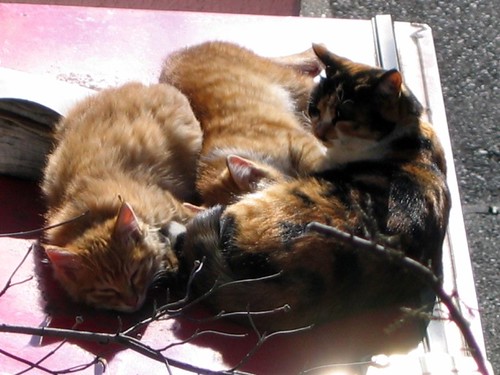
kawaii Our first morning in Tokyo: we wake up bagged, fragged and jet-lagged having spent the night in a fifteen square metre apartment with nothing but a futon the thickness of a panty liner between us and a cold wood floor. But it’s delightful. Because outside there are some *cute* cats sleeping on a Coke machine, bathed in the golden winter sun. That’s all that matters. What is it about Tokyo and cats? They seem to be everywhere, glowering from windows and bunched up like lost fur hats in the middle of the pavement of Ueno Park. Haruki Murakami used to run a jazz club in Tokyo called Peter Cat. Chris Marker always seemed to have a cat or two in his films. He described this city and its cats so beautifully in his (1982) Sans Soleil
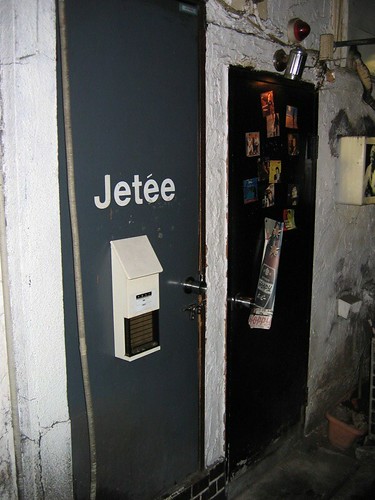
Jetée In Marker’s honour, we stop in at Jetée, which the owner Kawai san has decorated with cat figurines. We chat with her for a while over drinks and she tells us about Marker’s most recent film; ‘Chats perchés,’ which, sadly, we haven’t yet seen. But time is out of joint. It is the coldest winter in years and I am telling the story out of sequence. It doesn’t really matter. I’ll rely on photography. Again I think of Marker:
The Japanese have many words for cute. ‘Kawaii des ne?’ might cut it for cats but it isn’t the right flavour of cute to describe a Maid Café. So we head down to Akiba to investigate. Six stories above the street we join a queue, waiting for a tables in the At Home Café. The place is a seething madhouse of pink, with bevies of maids scurrying around, giggling and serving cupcakes and omelettes that have cartoon smiles drizzled onto them with ketchup. Every twenty minutes or so a floor show starts, where customers play games with the maids and have their pictures taken flanked by maids holding plates of cupcakes. This is the epitome of moe (mo-eh) cuteness, quite distinct from the kawaii. When she finishes pouring my tea, our maid shows me how to jiggle my arms and make a heart shape with my thumbs and forefingers, while I coo: “o-o-o-o-h . . . . mo-e !” appreciatively at my cup. It’s hard to know just what to make of these artificial rain forest dioramas that have been put in beside YVR’s international arrival and departure gates. The sound of running water is certainly soothing and the humidity sure helps juice up one’s sinuses after a dry flight. But what is *up* with those fake vine maples, sword ferns and salal ? If the intention here was to do ’green’ design, then surely they would have used living plants. Live plants after all, would have helped clean the air by absorbing giga-litres of stressed-out passenger breath and turning it back into sweet, breathable oxygen. And hey, they’re alive!, which would have offered a nice balance to the sterility of the built environment. But BC salal and vine maples wouldn’t have survived long in the season-lessness of central heating and constant artificial light. Tropical plants would have been more suitable. But that would have been ’off message.’ And therein lies the rub. These displays aren’t about green design. They’re about theme park. At YVR, the temperate rain forest is part of a brand identity with which British Columbia gets marketed to international tourists. Never mind that the real forest continues to get logged, flogged and fragmented with many of its dependent species, like the mountain caribou, spotted owl and Vancouver Island marmot, on the fast track to extinction. None of this need trouble us as we enjoy our lattés under the plastic groves of this ecological simulacrum. While the synthetic brook babbles and the last school of rock cod roils inside the art-directed confines of its 100,000 litre aquarium, we can be sure that, at least at the airport, nature will always there for us. YVR: Your Virtual Rainforest.  cousteau 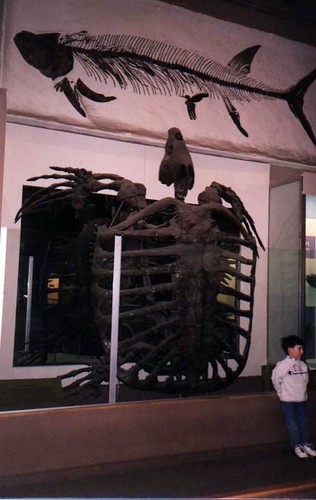 archelon Well I’m off to Japan for a couple of weeks. But before leaving, in honour of the Japanese tradition of cleaning house on New Year’s, I decided to change the swamp water in the aquarium that currently takes up most of our living room. This is the home of Cousteau, a fifteen-pound Florida softshell turtle, who has lived with us ever since she was a hatchling the size of an Oreo cookie.  tank cleaning time Cousteau is increasingly resembling a small dinosaur and if her growth rate doesn’t slow down she might start taking after her late Cretaceous cousin Archelon whose remains I once photographed at Yale’s Peabody Museum. Even some of Cousteau’s non- extinct relatives are known to reach enormous size. The highly endangered Asian species, Rafetus swinhoei, attains a weight of over 140 kg. There are only six individuals known still to be surviving. An enormous specimen inhabiting Hanoi’s Hoan Kiem Lake is regarded by the Vietnamese as a living god, reappearing from the murk from time to time, during periods of great import to the Vietnamese people. As for Cousteau, she has appeared again from the murk also. Now that her view, for the time being, is once again unobstructed, she is pressing her nose against the glass in the direction of the television whenever we watch the nightly news. While her sad reptilian eyes appear to be taking it all in, I wonder what she is thinking? 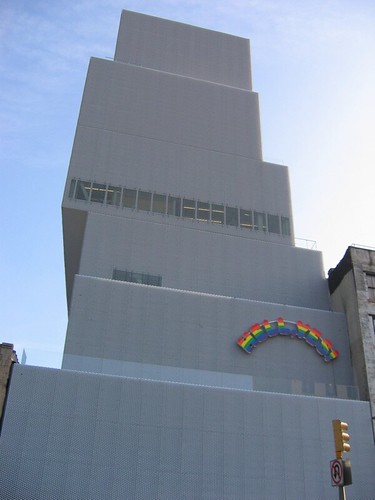 take a look at those cakes! At times, walking around New York can make me feel like I’m a little piece of metal hovering in the air between two electrically charged plates– one labelled: ‘old’ and the other: ‘new.’ It is a delightful state of limbo that can, at any given moment, collapse into either direction.  reading room 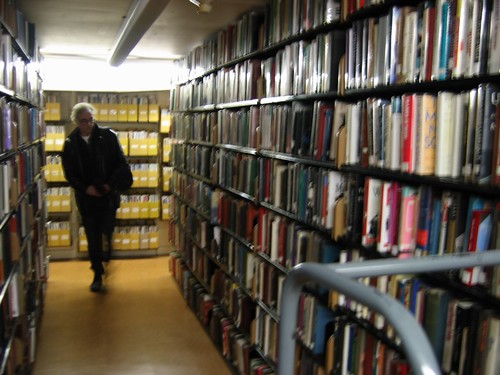 stacks With the Disneyfication of Times Square and the obliteration of iconic cultural landmarks like CBGB’s, it can seem at times that old New York is disappearing. It’s still there though, if you know where to look, peeking out coyly through the palimpsest of more recent development. A case in point is the New York Society Library, which has been in operation since 1754. Our pal Larry gave us a tour of its cosseted reading rooms on East 79th St. The place has a mystical, out of timeness to it, small yet somehow limitless — reminiscent perhaps of Borges’ Library of Babel. I could easily imagine a secret sect of bibliophiles inhabiting this place, spending their nights on little cots folded out between the tightly spaced shelves, so they would never have to be separated from their beloved volumes. After the perusing the stacks we stumbled over to the Metropolitan Museum to marvel at the exquisitely lustrous panels of the Ghiberti Gates, each one sealed in its own nitrogen-filled vitrine to protect the fragile gold leaf from our corrosive twenty-first century atmosphere. We wound up the evening toasting Borges and eating our dinner under the motorized windmills and Sancho Panza statuettes of El Quijote on West 23rd St. Pierre Menard would have been proud. 
panorama 1 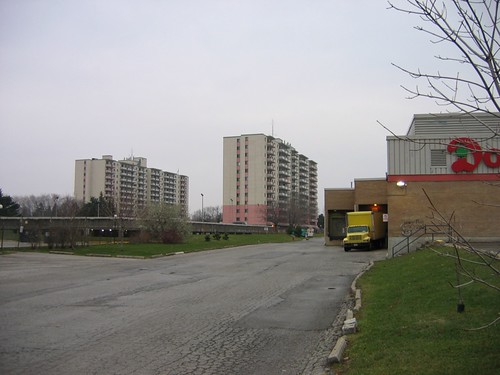
panorama 2 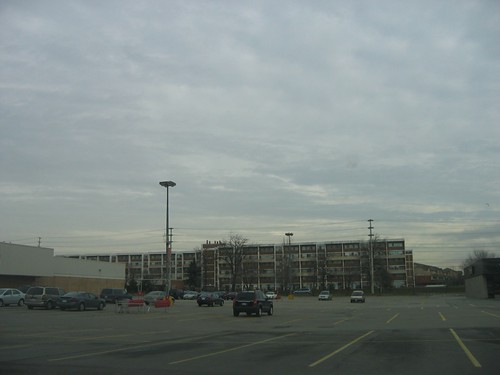
panorama 3 With considerable alarm Ruth and I had to jump on a plane recently to tend to my father in Mississauga, who had suddenly grown gravely ill, after what was supposed to have been routine surgery. We sat with him for a week, as he lay unconscious in the ICU, viscous fluids bubbling in and out of him through a maze of clear plastic tubing, his life rhythms governed by an army microprocessors and chirping screens. He is recovering, albeit in the slowest of increments, having recently regained consciousness. As one might expect, being around a critically ill parent brings up a lot of emotions around one’s own childhood and I found myself oddly nostalgic for the terrain vague of my youth. This rather unremarkable looking shopping plaza figured prominently in the psycho-geography of my family. I trekked across its windswept parking lot for seven years on my way to and from school. My mother and I each spent long hours working in its 24 hour grocery store; she for many years as an afternoon shift cashier and I, for a shorter stint, working nights as a meat room clean up attendant, pressure hosing blood off the white tiled walls and extracting balls of gristle from the clogged floor drains. They weren’t the easiest of jobs but the money was good and they helped us survive. I spent a lot of time working by myself in the loading dock, where I would prepare yellow plastic buckets of offal to be sent to a pet food factory. Sometimes, with the corrugated steel doors rolled open and the residual rumbling of a Great Lakes thunderstorm still ricocheting off the nearby apartment towers, I’d look out onto the glistening tarmac of the parking lot and think that life was magic. Perhaps it really was. |
||||||
|
Powered by WordPress · Atahualpa Theme by BytesForAll |
||||||




